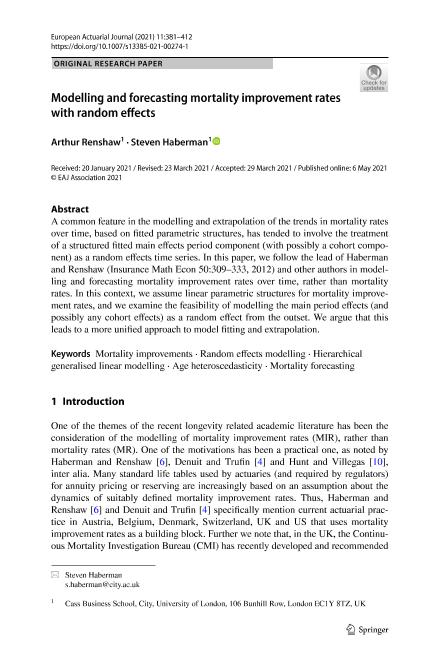| LDR | | | 00000cab a2200000 4500 |
| 001 | | | MAP20220007948 |
| 003 | | | MAP |
| 005 | | | 20220310171128.0 |
| 008 | | | 220310e20211206esp|||p |0|||b|spa d |
| 040 | | | $aMAP$bspa$dMAP |
| 084 | | | $a341 |
| 100 | 1 | | $0MAPA20110016920$aRenshaw, Arthur |
| 245 | 1 | 0 | $aModelling and forecasting mortality improvement rates with random effects$cArthur Renshaw, Steven Haberman |
| 520 | | | $aA common feature in the modelling and extrapolation of the trends in mortality rates over time, based on fitted parametric structures, has tended to involve the treatment of a structured fitted main effects period component (with possibly a cohort component) as a random effects time series. In this paper, we follow the lead of Haberman and Renshaw (Insurance Math Econ 50:309333, 2012) and other authors in modelling and forecasting mortality improvement rates over time, rather than mortality rates. In this context, we assume linear parametric structures for mortality improvement rates, and we examine the feasibility of modelling the main period effects (and possibly any cohort effects) as a random effect from the outset. We argue that this leads to a more unified approach to model fitting and extrapolation |
| 540 | | | $aLa copia digital se distribuye bajo licencia "Attribution 4.0 International (CC BY 4.0)"$uhttps://creativecommons.org/licenses/by/4.0$943 |
| 650 | | 4 | $0MAPA20080555306$aMortalidad |
| 650 | | 4 | $0MAPA20080592011$aModelos actuariales |
| 700 | 1 | | $0MAPA20080165116$aHaberman, Steven |
| 773 | 0 | | $wMAP20220007085$g06/12/2021 Volúmen 11 - Número 2 - diciembre 2021 , p. 381-412$tEuropean Actuarial Journal$dCham, Switzerland : Springer Nature Switzerland AG, 2021-2022 |
| 856 | | | $qapplication/pdf$w1114467$yRecurso electrónico / Electronic resource |


